Complete Guide to Barletta: Attractions and Beaches
Updated at: 20-09-2024
How this content can help you:
- How to reach Barletta
- Main attractions: Svevo Castle, Civic Museum, Colossus of Barletta
- Explore the historic center and the "Sette Strade"
- The beaches of Ponente, Levante, and the "Fiumara" coastline
- Places of worship: Basilica of the Holy Sepulchre, Cathedral of Santa Maria Maggiore
- The history of the Challenge of Barletta and its celebrations
- Visit to the Palazzo della Marra and the De Nittis Gallery
- The Curci Theatre and the cultural life of Barletta
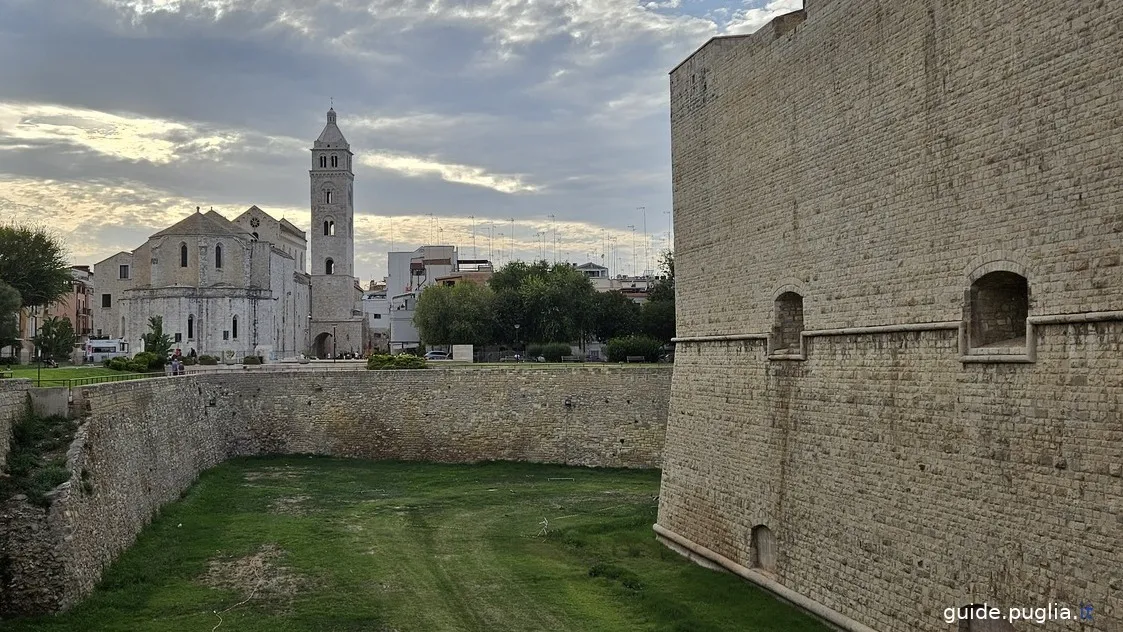
Barletta is a city located in the Puglia region, in the southeast of Italy. It lies on the Adriatic coast, in the province of Barletta-Andria-Trani (BAT), about halfway between Foggia and Bari.
Barletta is a city with a rich historical, cultural, and artistic heritage.
The history of Barletta is marked by many significant events, closely linked to its strategic location along the Adriatic coast, which made it a crucial meeting point for various peoples and cultures.
Once in Barletta, you can easily visit the historic center on foot, as most of the main attractions are concentrated in a compact area of the city.
How to get to Barletta:
By car:
- From Bari: Take the A14 highway north and exit at "Barletta." The trip takes about 45 minutes (approximately 60 km).
- From Foggia: Take the A14 south; the journey lasts about 45 minutes (approximately 70 km).
By train: Barletta has a well-connected railway station. There are regional and long-distance trains that connect the city with Bari (about 30 minutes) and other major cities like Foggia, Naples, and Rome.
By bus: Several bus companies connect Barletta with nearby cities, including local and interregional services.
By plane: The nearest airport is Bari-Palese Airport (Karol Wojtyła), about 50 km away. From there, you can take a train or rent a car to reach Barletta.
What to see in Barletta
Barletta offers a wide range of historical, cultural, and natural attractions worth visiting. Here are the main points of interest:
- Castello Svevo
- Civic Museum
- Colossus of Barletta (Eraclius)
- Basilica of the Holy Sepulchre
- Cathedral of Santa Maria Maggiore
- Palazzo della Marra
- Cantina della Disfida
- Porta Marina
- The "Sette Strade"
- Teatro Curci
- Barletta Cableway
- The historic center
- Beaches of Barletta
Castello Svevo:
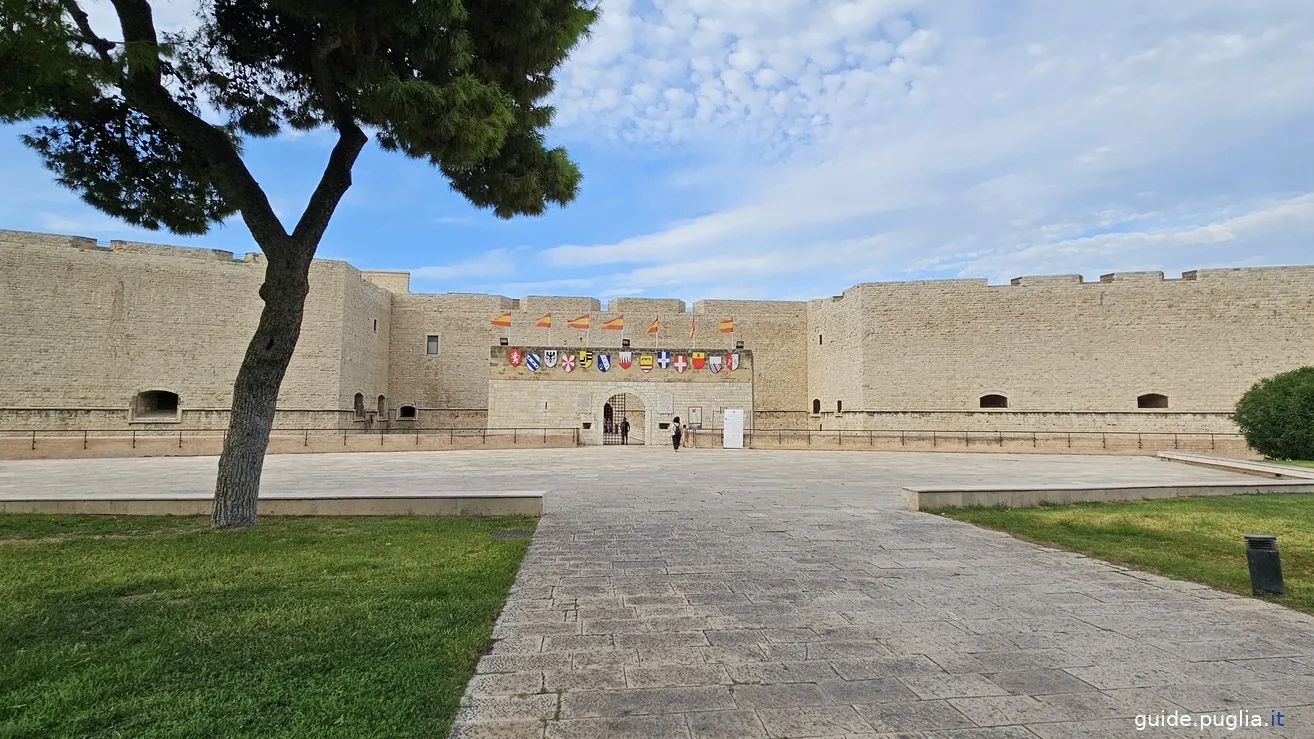
The Castello Svevo of Barletta is one of the city's most important symbols and represents an extraordinary example of medieval military architecture.
Its construction began in the 11th century under the Normans, but it was later expanded and fortified during the reign of Frederick II of Swabia in the 13th century, making it one of his fortified residences. In the following centuries, the castle underwent further modifications under the Angevins and Aragonese.
In the past, the Castello Svevo primarily served a military and defensive purpose. During the Middle Ages, it was a strategic point for controlling the surrounding territory and the Adriatic coast. It was used as a military garrison and as a residence for noble families that ruled the area.
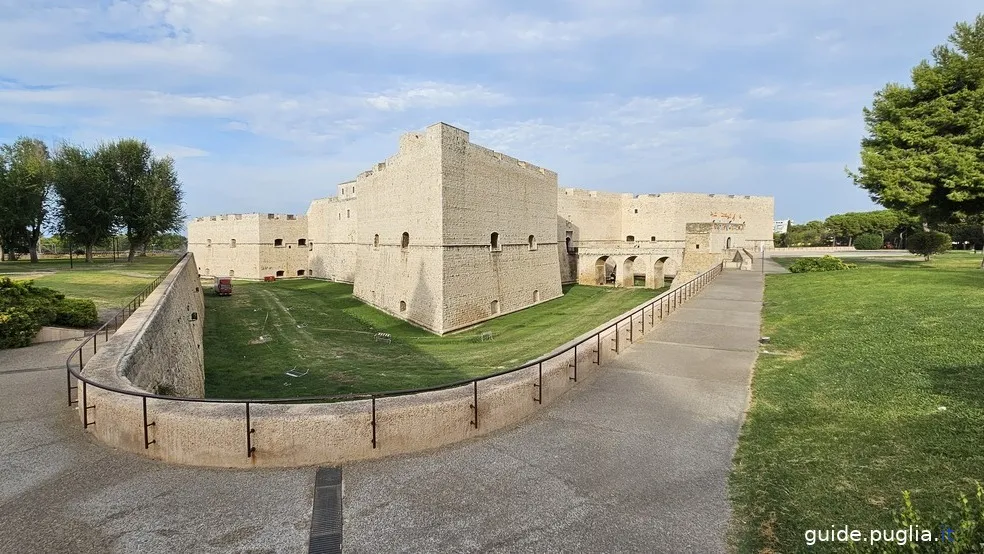
Over time, the castle underwent several transformations, adapting to the defensive needs of the era, including the addition of bastions to withstand cannon fire. During the Spanish rule, the castle also served as a military base and arms depot.
Inside, the castle has various rooms, including exhibition halls, courtyards, and a central keep, the highest part of the fortress. Today, the spaces are used for permanent and temporary exhibitions and offer a panoramic view of the city and the sea from the walls' walkway.

Today, the Castello Svevo is an important cultural center. It hosts permanent and temporary exhibitions, conferences, cultural events, and shows. The Civic Museum is located inside and houses archaeological and historical artifacts related to the city of Barletta. There is also a section dedicated to the castle's history and its various construction phases.
How to reach Castello Svevo:
The castle is located in the center of Barletta, a short walk from the seafront. It is easily accessible on foot from the historic center and the main tourist attractions. Additionally, it is well connected by the local public transport network.
What to see inside:
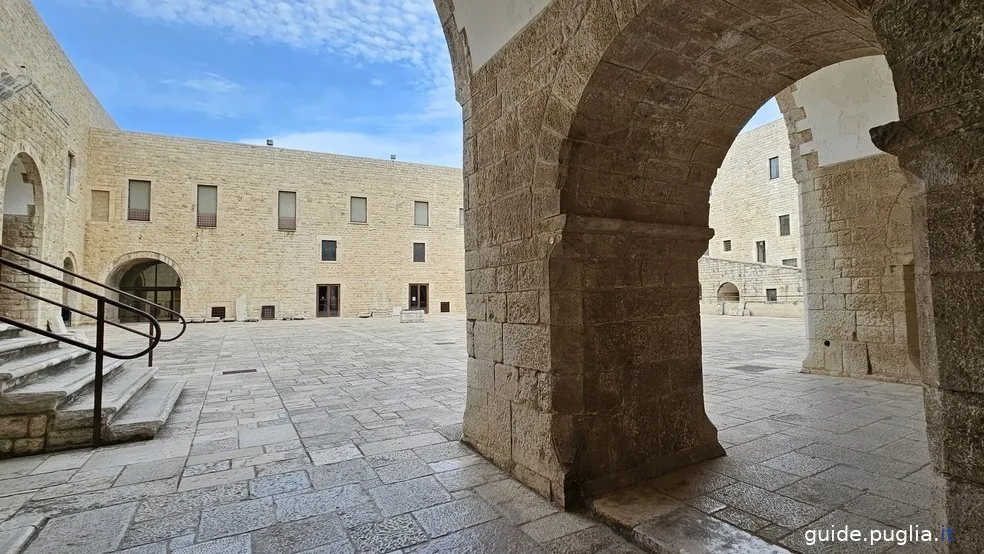
Civic Museum: Contains historical and archaeological artifacts that tell the history of Barletta and the region.
Temporary Exhibitions: Regularly hosts art and history exhibitions, often related to local culture or international themes.
Walls Walkway: This path allows you to walk along the ancient defensive walls of the castle, once used by sentries to patrol and monitor the surroundings in case of enemy attacks. Walking along the perimeter, you can see the arrow slits and embrasures through which archers and defenders could strike enemies without exposing themselves.
Panoramic View: From the walkway, you can enjoy a magnificent view of Barletta and the Adriatic Sea. On one side, you can admire the rooftops of the historic center with its churches and palaces, while on the other, a breathtaking view of the sea opens up, once the city's main connection and defense source.
During the walk along the walls, you can clearly see the architectural structure of the castle, the corner bastions, and the moat below. Moreover, you get a unique perspective on the old port and the seafront of Barletta. The view of the sea recalls the strategic importance of the castle as a maritime fortress, designed to protect the city from sea attacks.
Inner Courtyard: The central courtyard is a large open space inside the walls of the Castello Svevo. In medieval times, the courtyard was the center of life inside the castle. Military activities, ceremonies, and training sessions often took place here.
Today, the courtyard is used for cultural events, concerts, exhibitions, and outdoor performances. During the summer, it hosts concerts of classical music, jazz, and theatrical performances, offering spectators a unique context immersed in history. The courtyard is also the main space for historical reenactments related to the Disfida di Barletta, with parades and shows in costume. In addition to performances, the courtyard is often used for temporary exhibitions.
Opening hours:
The Castello Svevo is open to the public all year round. Opening hours vary depending on the season:
- Summer (June-September): Usually from 9:00 AM to 8:00 PM.
- Winter (October-May): From 9:00 AM to 6:00 PM.
Ticket prices:
The ticket price varies based on age and the presence of temporary exhibitions:
- Full ticket: Generally around 6-8 euros.
- Reduced ticket: Usually available for students, seniors, and groups (around 4-5 euros).
- Free admission: Often offered to children under 6, people with disabilities, and accompanying teachers
Civic Museum
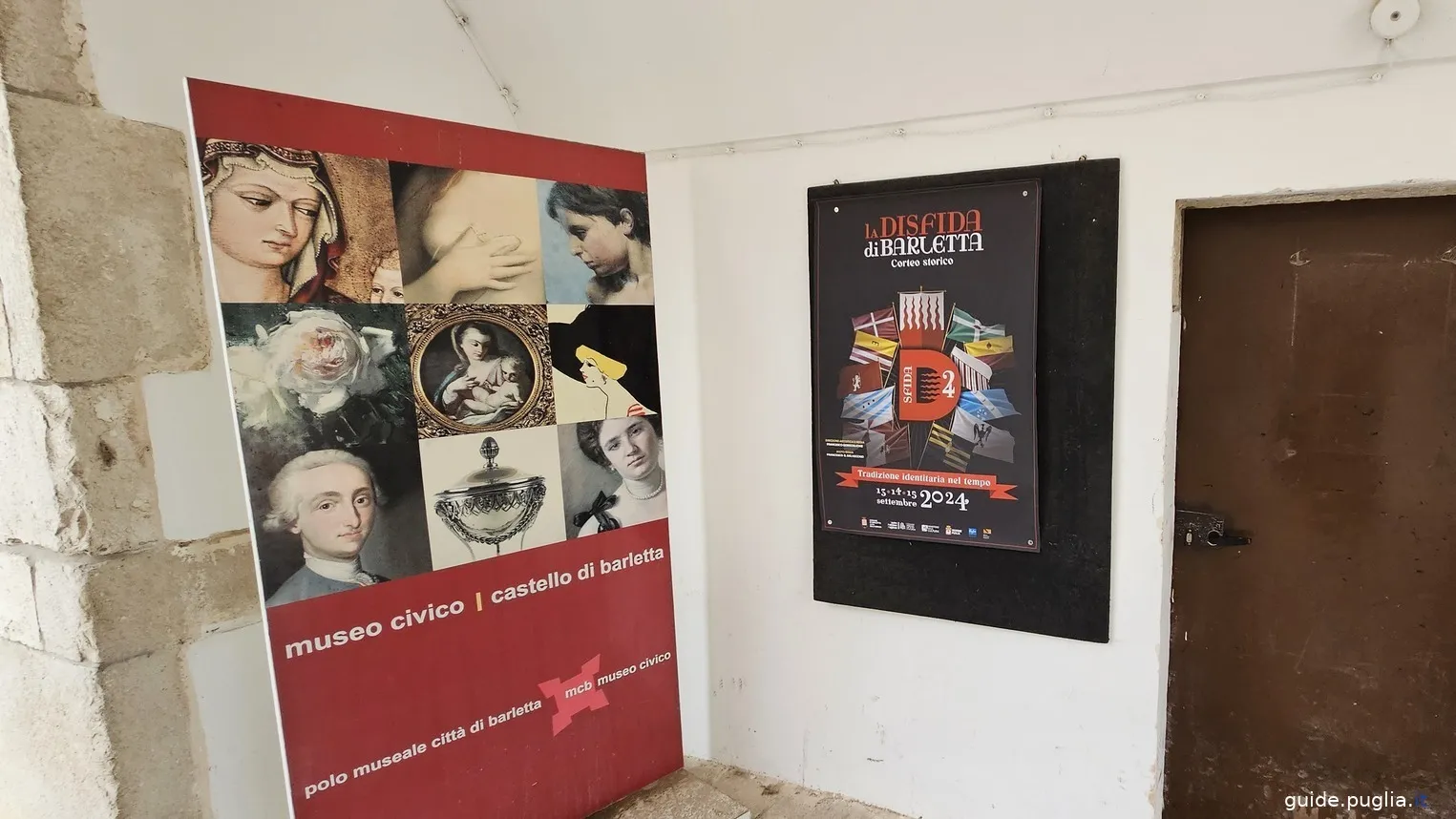
The Civic Museum of Barletta, located inside the Castello Svevo, houses a vast collection of historical and artistic artifacts that tell the long and rich history of the city and the surrounding region. The museum is a must-see for anyone wishing to deepen their knowledge of Barletta's past, from prehistory to the medieval and modern periods.
The museum is divided into different thematic sections, offering a journey through the centuries:
Archaeological Artifacts:
One of the main sections of the museum is dedicated to archaeological finds discovered in and around Barletta.
These include objects dating back to the ancient civilizations of Puglia, such as the Dauni and the Romans. Among the exhibited artifacts are pottery, weapons, tools of daily use, and funerary artifacts.
Medieval History:
An important part of the collection is linked to the medieval period, when Barletta became a crucial center under the Normans, Swabians, and Angevins.
The museum features documents, weapons, and armor that testify to the city's role as a fortress and strategic base, with particular attention to the Disfida di Barletta of 1503. There are also models and reconstructions showing how the city and castle appeared during the Middle Ages.
Sacred Art and Paintings:
The museum preserves a collection of sacred art from the Renaissance and Baroque periods. It includes paintings, statues, liturgical vestments, and religious objects from the churches of Barletta and the Cathedral of Santa Maria Maggiore.
Modern and Contemporary Section:
This part of the museum displays works by local and national artists, with special attention to the Impressionist painter Giuseppe De Nittis, who was born in Barletta.
While the De Nittis Gallery is housed in Palazzo della Marra, the Civic Museum includes several significant works by this famous artist.
Temporary Exhibitions:
The museum regularly hosts temporary exhibitions on both art and history, often linked to themes of regional or national interest. The exhibitions frequently change, offering a continuous variety of content for visitors.
Opening Hours:
The Civic Museum generally follows the opening hours of the Castello Svevo, but there may be variations depending on the season or special events. The typical hours are:
- Summer (June-September): 9:00 AM - 8:00 PM
- Winter (October-May): 9:00 AM - 6:00 PM
Hours may vary for temporary exhibitions or special events.
Ticket Prices:
The ticket price to visit both the Civic Museum and the Castello Svevo may vary depending on the exhibitions, but the general prices are:
- Full ticket: 6-8 euros
- Reduced ticket: 4-5 euros (for students, seniors, and groups)
- Free admission: for children under 6, people with disabilities and their caregivers, and sometimes for teachers accompanying school groups.
On special national culture days, such as the first Sunday of the month, entry may be free as part of initiatives promoted by the Ministry of Culture.
Colossus of Barletta
The Colossus of Barletta, also known as Eraclius, is a monumental bronze statue, about 5 meters tall, representing a Roman emperor. It stands outside the Basilica of the Holy Sepulchre in a small square in the city.
It is one of the largest surviving ancient bronze statues and one of the most iconic symbols of Barletta.
The statue depicts an emperor in regal attire, with a crown on his head, a richly decorated mantle, and a majestic posture. Some scholars believe it represents Emperor Theodosius II, while others suggest Valens, Arcadius, or another late Roman or Byzantine emperor.
In his right hand, the Colossus once held a cross, now missing, while his left hand grasps a globe, symbolizing imperial power.
Legends and Traditions
The statue is also the center of some local legends. One of the most famous tells that, at night, the Colossus may move and protect the city from potential threats. This legend is still alive among the people of Barletta, adding to the statue's enduring mystery and allure.
Basilica of the Holy Sepulchre
The Basilica of the Holy Sepulchre in Barletta is one of the city's most ancient and significant churches, closely tied to the Crusades and the Middle Ages.
Located along the Via Francigena, the pilgrim's route to Jerusalem, the basilica held great spiritual importance.
Its foundation likely dates back to the 12th century, and its name references the Basilica of the Holy Sepulchre in Jerusalem, one of the most sacred sites for Christians.
During the Middle Ages, Barletta's church became a crucial stop for crusaders and pilgrims traveling to the Holy Land.
In the period of the Fourth Crusade (1202-1204), the basilica served as a refuge for knights and pilgrims returning from Jerusalem.
The Basilica of the Holy Sepulchre in Barletta houses a relic associated with the Cross of Jesus. This relic is a fragment of the True Cross, the cross on which, according to Christian tradition, Jesus was crucified.
The relic is the object of deep devotion among the faithful and is displayed during special liturgical celebrations, such as during the Feast of the Exaltation of the Holy Cross, celebrated on September 14th. On this day, the cross is carried in procession and venerated by the faithful.
Cathedral of Santa Maria Maggiore

The origins of the Cathedral of Santa Maria Maggiore date back to the 11th century, when it was built on the remains of an earlier paleo-Christian basilica. During the 12th century, under Norman influence, the church was expanded and took on the Romanesque appearance that still characterizes parts of it today.
In the following centuries, especially during the Gothic period, the cathedral underwent further modifications and expansions.
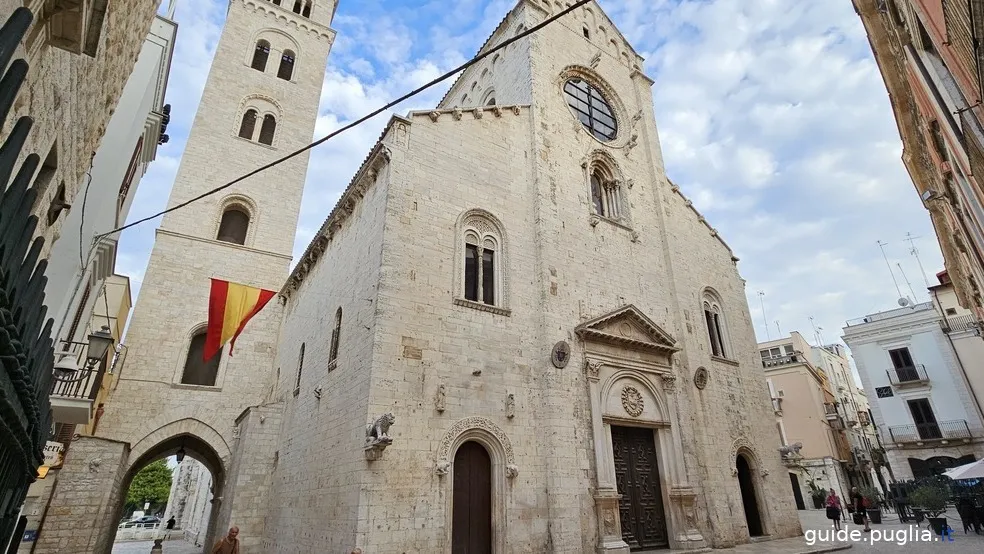
The cathedral became an important religious landmark for Barletta and the entire region, playing a crucial role in the spiritual and cultural life of the city. Next to the cathedral stands a medieval bell tower, built later than the church, which dominates the surrounding square.
One of the most fascinating elements of the cathedral is the paleo-Christian crypt, located beneath the main building.
This crypt is a precious example of early Christian religious architecture, with frescoes and decorations dating from that period. The crypt is open to visitors and is one of the most interesting sites within the cathedral.
Palazzo della Marra
This historic noble palace, located in the heart of the city, is now home to the Pinacoteca De Nittis, an art collection dedicated to the famous Impressionist painter Giuseppe De Nittis (1846-1884), a native of Barletta.
The pinacoteca holds around 200 works by the artist, including paintings, pastels, and drawings, which were donated to the city by De Nittis' wife, Leontine Gruvelle, after the artist’s death.
The exhibited works cover different phases of De Nittis' career, showcasing his ability to capture light and fleeting moments of modern life.
In addition to the permanent collection, the palace regularly hosts temporary exhibitions of modern and contemporary art.
Cantina della Disfida
The Cantina della Disfida is a symbolic and historic place in Barletta, linked to the famous episode of the Disfida di Barletta, one of the most glorious and legendary moments in Italian history.
The cantina is visited every year by numerous tourists and history enthusiasts due to its significance and connection to this chivalric event.
The Cantina della Disfida holds great historical and symbolic significance. It has become a place of remembrance for national pride and a symbol of courage and loyalty.
The victory of the Italian knights in the disfida is considered a demonstration of Italian valor and is celebrated annually with events and historical reenactments.
History of the Cantina della Disfida
The Disfida di Barletta took place on February 13, 1503, during the Italian Wars between the French and the Spanish over control of the Kingdom of Naples. The disfida was a chivalric challenge between 13 Italian knights, led by Ettore Fieramosca, and 13 French knights.
The conflict arose in response to an insult from the French, who had questioned the bravery and courage of the Italian knights.
According to tradition, the Cantina della Disfida is the place where the Italian knights, including the famous Ettore Fieramosca, gathered to decide to accept the challenge and organize themselves for the battle.
It is thus considered the place where the planning of the battle, which eventually ended with the victory of the Italians, began—an event that deeply marked both local and national history.
The Cantina Today
Today, the Cantina della Disfida is a museum that allows visitors to immerse themselves in the history of that legendary event. The interiors of the cantina have been restored to recreate the 16th-century atmosphere, complete with period furnishings, armor, and historical documents that testify to the disfida.
Inside the museum, visitors can:
- Admire reproductions of weapons and armor similar to those used by the knights.
- View historical documents and explanatory panels that tell the story of the disfida.
- Participate in guided tours that provide a detailed explanation of the historical context and the personalities involved in the event.
Opening Hours and Admission
The cantina is generally open every day.
The opening hours of the Cantina della Disfida may vary depending on the season and ongoing events. Usually, it is open to the public at the following times:
- Summer (June to September): 10:00 AM - 1:00 PM and 4:00 PM - 8:00 PM
- Winter (October to May): 10:00 AM - 1:00 PM and 3:00 PM - 6:00 PM
Ticket Prices
The entrance fee to visit the cantina is generally affordable, with the following indicative rates:
- Full ticket: around 3-5 euros
- Reduced ticket: available for students, seniors, and groups (around 2-3 euros)
- Free admission: often for children under 6 and people with disabilities.
Reenactment of the Disfida
Every year, on February 13, Barletta celebrates the anniversary of the Disfida with a series of events, including historical reenactments in costume, parades, and lectures that attract tourists and history enthusiasts from all over Italy.
During these celebrations, the Cantina della Disfida becomes a central point for the commemorative events.
In September, a historical reenactment of the Disfida di Barletta is held, commemorating the 1503 event. The celebrations include parades in period costumes, theatrical performances, historical processions, and knightly tournaments, which involve the entire city in a grand celebration.
This reenactment usually takes place in the second half of September and is an important moment for Barletta to relive the challenge between Italian and French knights, keeping the historical memory alive.
Porta Marina
Porta Marina, located in the heart of Barletta's historic center, near the seafront, is one of the ancient gates of the city and part of its medieval walls.
It once served as one of the main entrances to the urban center, connecting the city to the port and the Adriatic Sea.
Built in the 13th century, Porta Marina is a significant testament to Barletta's medieval defense system, at a time when it was an important commercial and strategic hub on the Adriatic Sea.
Surrounded by mighty walls, the city was protected from attacks coming from the sea, and Porta Marina was one of the crucial entrances through which goods and people from the port passed.
The gate was an integral part of the defensive walls and played a strategic role in controlling traffic and defending the city.
Although the defensive importance of the walls diminished over the centuries, Porta Marina continued to maintain its relevance as a symbol of Barletta's connection to the sea.
The gate is adorned with carved decorations, including the city's coat of arms and various ornamental elements that emphasize its historical importance.
Overlooking the sea, it offers a suggestive panoramic view of the port and seafront of Barletta.
During historical and cultural events, such as the Disfida di Barletta celebrations, Porta Marina becomes a central point for historical parades and reenactments.
Its strategic location and historical significance often make it the starting or ending point for processions and celebrations that enliven the city.
The “Sette Strade”
The Sette Rue, also known as Sette Strade, is an intricate system of alleys and narrow streets located in the historic center of Barletta.
This characteristic network, which develops in the oldest part of the city, reflects the medieval urban layout, where narrow and winding streets were designed for both defensive reasons and to facilitate commercial and social activities.
The name Sette Rue comes from the number of streets that converge at a central point, forming an intricate and charming network of pathways typical of medieval cities.
This system likely developed between the 13th and 15th centuries, when Barletta was an important commercial and maritime hub on the Adriatic coast.
The Sette Rue, in addition to ensuring effective defense due to their structure, were the heart of the city's economy, with artisan workshops, merchants, and noble houses that animated the daily life of the city.
Today, the Sette Rue is a historic area of great charm, included in many tourist and cultural itineraries.
Visitors and residents can explore this ancient district, which retains its medieval atmosphere intact. During events like the Disfida di Barletta reenactments, the area comes alive with historical parades and celebrations, maintaining the connection with Barletta's tradition and history.
Teatro Curci
Inaugurated in 1872, it is dedicated to the Barletta composer Giuseppe Curci, an important 19th-century musician.
The construction of the theater began in the mid-19th century to meet the growing demand for a space dedicated to the performing arts in the city of Barletta. Before its creation, the city did not have a theatrical structure that met the cultural needs of the time.
The design was entrusted to the Barletta architect Luigi Santacroce, who created a building inspired by the most prestigious Italian theaters of the time.
Teatro Curci has an elegant and imposing structure characterized by its horseshoe shape and the boxes surrounding the stalls.
The neoclassical facade of the theater features a portico decorated with columns that give the building a majestic appearance.
Inside, the theater is decorated with stuccoes, frescoes, and red velvet, offering a refined atmosphere typical of 19th-century theaters.
The main hall is adorned with a frescoed ceiling depicting allegorical scenes, and the stage is framed by an elegant and richly decorated proscenium.
Teatro Curci is the center of Barletta's theatrical and musical activities. Its programming includes a wide variety of performances, including:
- Opera
- Symphonic music concerts
- Plays
- Ballet
- Cultural events and conferences
During the theater season, Teatro Curci hosts performances by local, national, and international companies, attracting a diverse audience and contributing to the city's cultural growth.
The theater also organizes events for schools and workshops for young artists.
Located near Teatro Curci is the Galleria del Teatro Curci, a shopping gallery that serves as an important meeting point for the city's social and commercial life.
It is located on Corso Vittorio Emanuele, just a few steps from the theater, and is a covered pedestrian passage offering a variety of shops, cafés, and exhibition spaces.
Teleferica di Barletta
The teleferica of Barletta was connected to the salt pans of Margherita di Savoia, known for being among the largest in Europe.
One of the main materials transported by the teleferica was salt from the salt pans.
This system allowed the salt to be transported directly to the port of Barletta, from where it was then shipped for export to international destinations.
The connection between the salt pans and the port was a strategic factor for the salt trade, which was managed on a large scale.
Inaugurated in 1955, the teleferica was one of the most advanced infrastructures for salt transport, replacing existing rail links. Built with concrete pylons and suspended baskets, the structure extended for 13 km, with over a kilometer and a half crossing the sea, and the rest on land supported by seven pylons about 20 meters high.
This system was capable of transporting up to 180 tons of salt per hour, making it a vital economic and logistical infrastructure for the region.
However, the teleferica was decommissioned in 1981 due to high management costs.
In 2000, the pylons rising from the sea were demolished, leaving an indelible mark in the memory of the people of Barletta, who for decades had seen this iconic structure from the Ponente waterfront.
Today, the municipal administrations of Barletta and Margherita di Savoia are working to restore and musealize some of the surviving buildings and structures of the teleferica, with the aim of enhancing the area for both tourist and cultural purposes.
Historic Center of Barletta
The historic center represents the oldest part of the city, also known as Barletta Vecchia. It is a charming area where numerous historic monuments, medieval and Renaissance buildings, narrow alleys, and picturesque squares tell the long history of the city.

Barletta Vecchia is characterized by a network of narrow, winding streets typical of medieval cities, many of which still retain the ancient stone paving.
This area is the original core of the city and largely preserves its historic urban structure.
The buildings are often constructed of limestone, typical of Apulian architecture, and many date back to the 12th and 13th centuries, when Barletta began to gain significant importance both commercially and militarily.
The historic center is not only a place of great historical value but also a lively and frequented area.
Its narrow streets and welcoming squares host artisan shops, restaurants, and cafés, where you can enjoy the typical dishes of Apulian tradition.
Beaches of Barletta
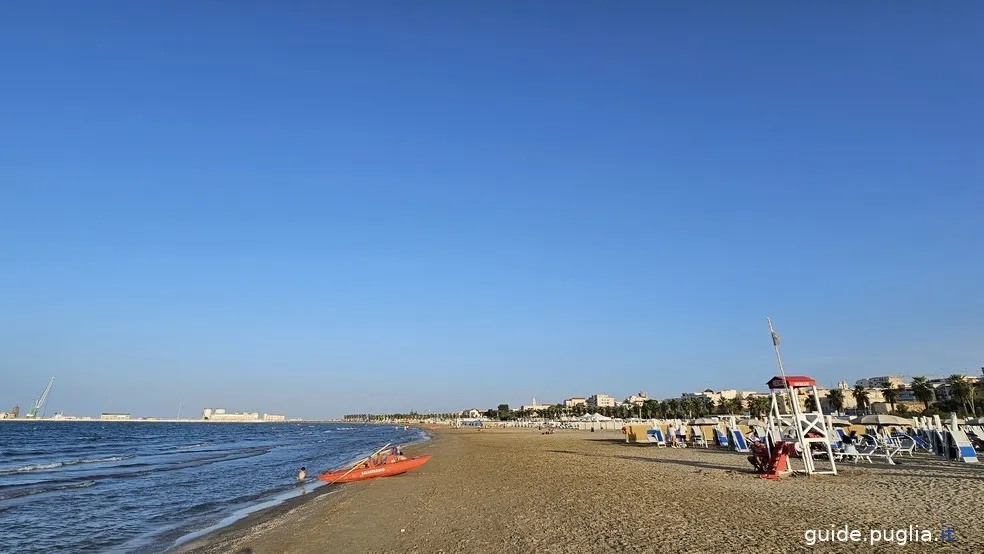
The beaches of Barletta overlook the Adriatic Sea and are among the most appreciated spots by both residents and tourists, especially during the summer months.
With a coastline stretching about 13 kilometers, Barletta offers a mix of sandy beaches and more natural coastlines, making the area ideal for families, sports enthusiasts, and those seeking relaxation in the sun.
The beaches of Barletta are easily accessible from the city center and are well-connected by public transport. Additionally, many beaches provide accessible entrances for people with disabilities and assistance services to ensure an inclusive experience for all.

Thanks to the water quality and the services offered, the beaches of Barletta have received the Blue Flag in the past, an international recognition awarded to beaches with high environmental and management standards.
The main beaches in Barletta include the Ponente Beach, the Levante Beach, and the Fiumara coast.
Ponente Beach
The Ponente Beach is the most popular beach in Barletta and stretches west of the city center.

It is characterized by fine golden sand and is long and well-equipped, with beach establishments offering all necessary services, including sunbeds, umbrellas, bars, and restaurants.
Levante Beach
The Levante Beach extends east of the Barletta port. This is also a sandy beach and is equipped with well-organized beach establishments.
Here, you can enjoy water sports like windsurfing and kitesurfing, thanks to the winds that blow in this part of the coast.
The beach is less crowded than Ponente Beach, but it still offers comfort and services, as well as quieter spaces for those seeking relaxation. The Pietro Mennea promenade, dedicated to the famous Barletta sprinter, runs along this beach and is an ideal spot for evening walks.
Fiumara Coastline
This stretch of coastline is located in the most natural part of the Barletta seafront, north of the city. It is a less developed area, characterized by free beaches and a more wild environment.
It is particularly appreciated by nature lovers and those seeking greater tranquility away from the more crowded beach establishments.
Here, dune vegetation blends with the clear waters of the sea, offering a sense of immersion in nature. Despite the fewer tourist facilities, it is frequented by those looking for a more authentic and natural experience.
In this area, there was once a watercourse flowing into the Adriatic Sea, creating a sort of temporary stream or fiumara. Although the area is now primarily used as a beach, the name "Fiumara" remains tied to the area's hydrogeological past.
